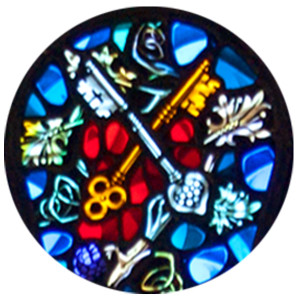12 o’clock. Keys. Peter. This symbol refers to Matthew 16:18-19.
18 “And I tell you, you are Peter, and on this rock I will build my church, and the gates of hell shall not prevail against it. 19 I will give you the keys of the kingdom of heaven, and whatever you bind on earth shall be bound in heaven, and whatever you loose on earth shall be loosed in heaven.”
Peter is believed to have been crucified upside down.
The scene is depicted in the Crucifixion of St. Peter by Caravaggio. This painting from the Baroque period is beyond amazing. (See link above.)
Born in the Sixteenth Century, Caravaggio was a bit of a rock star. He was perhaps the most famous painter in Rome for a period while at the same time amassing a police record. He died while still in his thirties.
He was a brilliant artist. His rendering of surfaces was exceptional. The facial expressions of his subjects could be used as a textbook on human emotion. These capabilities are only part of what Caravaggio uses to create the drama and mystery we see in the Crucifixion of Saint Peter.
The scene is paired down to become very minimal. The normal crowds and landscapes are gone or have fallen entirely into shadow.
We see four men with the spotlight on Peter. There are three executioners. The executioner dressed in green (dark green in some images) strains to raise Peter with a rope. A second in red assists. The third in a muted gold color heightens the drama. In the spotlight with Peter, the third executioner has just dug a hole for the cross to rest in. The shovel is still in his hands and his feet are covered with dirt. The muscle forms in his lower right leg flex as he strains to lift an old, but still very physical Peter. His rear end comes out of the frame of the painting into our reality. We feel gravity and mass in this image.
Peter is fully lit from above with two small shadows falling across his body causing his feet and his knees to become pronounced. The affect is that these portions of his body also appear to break out of the frame and enter into our world. His feet and his left hand have large spikes going through them attaching his body to the cross. Only the tiniest suggestion of blood is introduced.
The facial expression of Peter is the high point of the image. This is no longer the young, hot blooded apostle who cut off the ear of the High Priest’s servant. The mature Peter here looks introspective and reflective. One pauses at this point to consider what Peter is thinking. Is he reflecting on what Jesus went through? Is he thinking of work for the Kingdom that he has left unfinished? Or perhaps his thought is that he will soon join Christ again in a new reality.
In part 17, we conclude.

